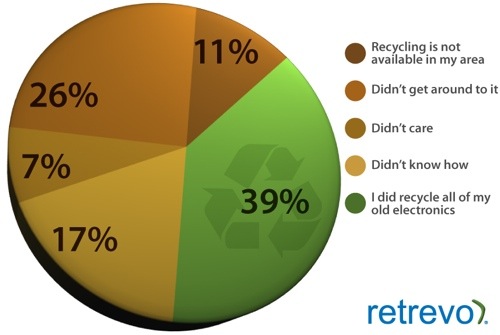By Andrew Eisner
It seems like every time you turn around a new and better smartphone or HDTV set goes on sale. That’s great for consumers who are eager to upgrade to the latest gadgets but it’s maybe not so good for the environment.
The bad news is 60% of Americans are not recycling their old gadgets. The good news is that resellers and manufacturers are rising to the occasion and implementing their own recycling services. In this Gadget Census report we look at how consumers across the country are being green with gadgets and what is being done to help manage the growing number of devices that are turning into e-waste every day.
Based on a 2008 EPA report, we calculate that by the end of 2010 there will be so much e-waste accumulated (since the year 2000), it could cover the island of Manhattan in old electronics three feet deep. Factoring in data from this same EPA report, we project by the year 2020 there will be so many old, unused, or broken computers, printers, cell phones and TVs, they could fill enough dump trucks to circle the earth twice.
As the U.S. Census was winding down, Retrevo was tabulating the results of its own Gadget Census that involved over 7500 households across the country and around the world. Participants answered a long list of questions about the gadgets they owned and how they used them. Some of the questions involved how actively they recycled their old gadgets.
In the Gadget Census, the most common excuse and possibly least defensible for not recycling was, I just didn’t get around to it. Good intentions are fine but action is what’s needed now. On the other hand, the smallest number of potential recyclers said they, “didn’t care.” That’s also good news because apathy would be harder to overcome than motivating a group of procrastinators who are pre-disposed to recycle. If procrastination was the most common excuse, lack of knowledge comes in second with 20% of Americans who don’t recycle saying they didn’t know how. Making consumers more aware of recycling services should be straightforward to accomplish.
Overall, almost one third of the U.S. respondents (28%) said they recycled their old gear. The top states in the country for gadget recycling include California, Minnesota, Maryland, and Oregon who is out in front with 53%. The top four greenest metro areas of the country are the San Francisco Bay Area, Washington D.C. Metro Area, Phoenix and Los Angeles.
The third most common excuse for not recycling is the fact that it’s not available. In many cases this is being addressed by resellers and manufacturers who are stepping up and providing recycling services for old consumer electronics products. Costco, Sam’s Club, and others offer a trade-in program for old gadgets and gear as well as recycling services that will dispose of them properly. Office Depot gives you a box that you fill up with your old gadgets and take back to the store. Unfortunately, each box costs up to $15.
Best Buy has set a goal to collect 1 billion pounds of electronics and appliances for recycling and has equipped every store in the U.S. with a kiosk where you can drop off old gadgets and consumables for free. There are also individual companies getting involved like ecoATM offering a kiosk-based service for trade-ins on old cell phones. Many manufacturers are also offering lots of different recycling, buyback, and trade-in services for handling old devices. Apple for example, offers free recycling of its products and in some cases applies cash back and discounts toward future purchases.
Everyone needs to do their share whether it’s taking the initiative to find out how to recycle old gadgets or manufacturers and resellers offering recycling services for products they make or sell. We don’t want to get up on our soap box and start preaching to Americans to become more green with their electronics (or do we?) but it looks like there’s plenty of room for improvement with education, motivation, more community recycling services and more manufacturer and reseller recycling services topping the list of needed improvements to boost recycling of old electronics.
This census was conducted online from March, 2010 through July, 2010 and received over 7,500 individual responses from Retrevo users distributed across gender, age, and location. Responses were weighted based on reported demographics to gain accurate estimations of gadget ownership and usage within and across demographics. All data is therefore reported as weighted data in which most responses have a confidence interval of +/- 4% at a 95% confidence level.
Projections on e-waste accumulation were based on the EPA’s 2008 report and the approximate volume by mass of e-waste. 50% of gadgets nearing end-of-life (EOL) per the Gadget Census were assumed to be sold or donated and not included as e-waste.
For more about Retrevo’s Gadget Census Reports go to http://www.retrevo.com/content/gadget-census .
(Andrew Eisner is a computer journalist and the director of content for the consumer electronics shopping and review site Retrevo.com. Retrevo.com is one of the largest consumer electronics review and shopping sites in the world, helping people decide what to buy, when to buy, and where to buy. Retrevo uses artificial intelligence to analyze and graphically summarize more than 50 million real-time data points from across the web to give shoppers the most comprehensive, unbiased, up-to-date product information they need to make smart, confident purchasing decisions for electronics.)



